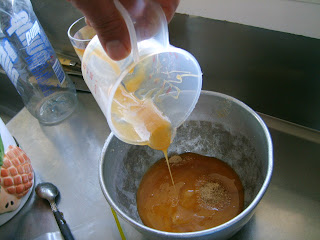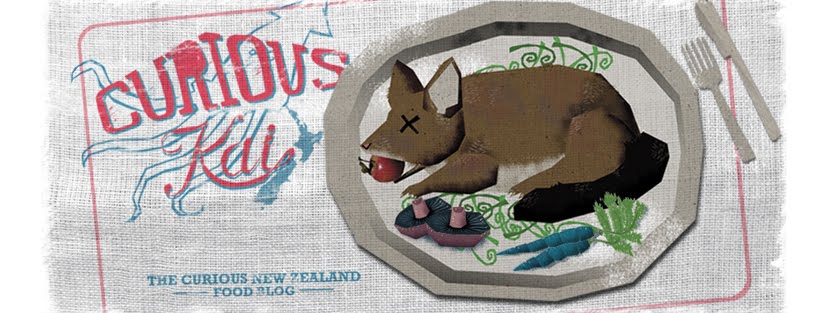
 From the top: UK & US pork cuts (pics courtesy of Wikipedia)
From the top: UK & US pork cuts (pics courtesy of Wikipedia)If pork is the king of meats, then bacon would be like Princess Diana: loved by everyone, not around for long but enjoyed to the utmost while it was (I'm not sure where Dodi Fayed fits in here - a good foreign sausage, perhaps?).
Lovely bacon takes effort to find and can be rather expensive. Store-bought bacon, while not as pricey, doesn't cook well, releasing water and foam the moment it hits the pan. As for the taste, well, there's a good reason why you don't come across many poems titled, "Ode to Bog-Standard Bacon".
Imagine my delight then, when a few weeks ago I came across this intriguing post (via Metafilter) showing how you could make your own wet cure, resulting in the best tasting bacon in existence. It seemed relatively straightforward too, so with that it was off to the butcher and the supermarket.

I bought half a pork belly which I then cut in half again at home. A pork belly makes for great streaky bacon, as you can see below.

The ingredients: with two pieces of belly to play with, I decided on using Dave's maple syrup mix on the first piece:
1/2 cup maple syrup
1/2 cup salt
1/2 cup brown sugar
and with the other, manuka honey (3/4 cup) and salt (1/3 cup). Honey is ideally suited for use in a wet cure. It serves the dual purpose of adding flavour, as well as being hygroscopic, which allows it to absorb moisture from the meat (more on this later). Working in action with the salt, this would prove to be a very effective cure.
Combine your ingredients and then rub into the raw pork bellies.

Once your belly is coated, pop it inside a sealable bag. Lay on a flat surface inside your fridge - its home for the next seven days - and turn the bag every two days. Oh, and don't use the crappy, over-priced "zip slide" bags you can see in the picture below. The wet cure seeped out of the end where the zipper-thingy was located.
 Time for a science lesson. As mentioned before, the salt and honey serve to lower the moisture content in the meat. This will hopefully prevent bacterial spoilage and maximise the effectiveness of the smoking process. Salt is a deliquescent material; that is, it absorbs moisture from a material and forms a liquid solution.
Time for a science lesson. As mentioned before, the salt and honey serve to lower the moisture content in the meat. This will hopefully prevent bacterial spoilage and maximise the effectiveness of the smoking process. Salt is a deliquescent material; that is, it absorbs moisture from a material and forms a liquid solution.In the case of the honey, there are two principal sugars involved in achieving this end, glucose and fructose. According to Peter Brey from Airborne Honey, the amount and ratios of these two sugars varies from honey type to honey type. Fructose is hygroscopic and glucose is not. In the initial instance, the fructose would absorb moisture from the bacon up to a point of equilibrium.
In terms of imparting flavour, Peter suggests putting some thought into the honey you choose. Mild-flavoured honeys would not add any flavour other than sweetness, while medium-flavoured honeys could add a certain "something" and strong-flavoured honeys could make or break the flavour.
The amount of liquid in the bags increased markedly as the week progressed. At weeks end, they came out of the fridge, were drained and the bellies removed from their bags. Looking at them both, the pieces had shrunk considerably in size and were noticeably darker in appearance (see below), with the maple syrup-cured belly being the most changed.
At this stage, you should rinse them thoroughly, place them uncovered on a rack, and put them back in the fridge for twenty four hours. What's going to happen here is the development of the pellicle on the surface of the meat. This is a sticky, tacky layer that will perform a few key functions. Firstly, it seals the moisture remaining in the flesh; it prevents oils and fats in the flesh from rising to the surface and spoiling during smoking; and lastly, it provides a layer for the smoke to adhere to (information courtesy of Jay Harlow).

With the twenty four hours up, it's time for the hot smoking! Ordinarily, I would have used my little smoker, but I needed to be able to maintain a low heat for a longer period of time than it would have allowed. So with the beta-bacon in hand, it was off to Kerry's house to use his gas barbecue for the hot smoking process.
I planned on using different wood chips to smoke the meat; manuka chips for the manuka honey-flavoured bacon, and apple wood for the maple syrup-flavoured bacon. The apple wood isn't as strongly scented as manuka chips, ideal if I didn't want to overwhelm the flavour of the maple syrup.
Kerry lined the grill plate with foil and placed the first batch of wood shavings on top. These were formed into a mound, so as to prevent it from catching alight. The barbecue was lit, and kept at a low heat. Once the mound of chips started to smoke, the rack supporting the first pork belly was placed over the top.

Place your meat skin-side up so the smoke will rise and permeate the meat. Also, as the heat rises, the substantial layer of fat and collagen will gradually melt, basting the belly. We're trying here to achieve an internal temperature of 70 degrees celsius (150-ish fahrenheit) - use a meat thermometer and poke it in the thickest part of the belly. Put the lid back down when you're finished so the smoke can work its magic.

Voila! Looking like this, it's little wonder the ancient Spartans ate it four times a day, believing it helped them to victory in so many battles*. Now, it could be eaten as is, but we are making bacon after all. Allow to cool and then cut to the thickness your heart (medical premiums up to date, hmm?) desires. Pop into a heated pan - no oil needed, there's quite a bit of fat on the belly - and fry away.

*patently untrue
And here we have the end product: thick slices of the most juicy, flavoursome bacon you will have this year.

Both pieces came out tasting wonderful. The maple syrup-flavoured bacon had a rich, sweet flavour with a pleasantly salty aftertaste. The manuka honey-flavoured bacon had a delicious woody flavour enhanced by smoking, with a distinct honeyed aftertaste. Both were smoked perfectly. This is now going to be a regular occurrence in my household - who can resist proper bacon! Let me add too, with hand over heart, that I will never buy bacon from a supermarket again. It would be interesting to try this with free range pork, or better still, wild pork - interesting flavours to be had from those two quarters.
A big "huzzah!" to the following folk: Kerry for the use of his barbecue and his smoking skills; the helpful (and hot!) Irish lady with the gorgeous accent at the PPCS meat store in Hastings; Peter Bray from Airborne Honey; and Dave Selden at BS Brewing, his home-made bacon being the inspiration for this post.
PS. For the curious and those with a bit of time on your hands: bacon placemats!








5 comments:
Heh, I saw the same post and was similarly inspired. My first effort looked fabulous but came out a bit on the salty side. After soaking in water it tastes pretty good though and is fabulous in bacon & egg sandwiches.
I like the manuka honey idea, and also the idea of smoking slowly in a BBQ, I used a fish smoker and it got the meat up to temp in only about 45 minutes, it did still give a nice flavour though (using oak sawdust).
And I completely agree about the zip slide bags, they suck.
Julian.
Wow, I'm impressed. Great to have some nice bacon that isn't full of water.
Julian, your bacon looks great! How long did you soak it for? Mine was salty but I didn't think it was overly done.
Barb, it's an easy process and the wait makes it all worth while!
bacon placemats?! wtf?
A far easier way of minimising mess and clutter is to simply throw your brine ingredients straight into the sealable bag, close it and knead until combined - throw in your pork belly and you're set.
Post a Comment